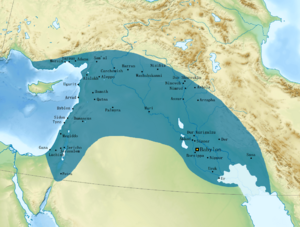Labashi-Marduk facts for kids
Quick facts for kids Labashi-Marduk |
|
|---|---|
|
|
| King of the Neo-Babylonian Empire | |
| Reign | April – May/June 556 BC |
| Predecessor | Neriglissar |
| Successor | Nabonidus |
| Died | May/June 556 BC Babylon? |
| Akkadian | Lâbâši-Marduk Lā-bâš-Marduk |
| House | Puqudu |
| Dynasty | Chaldean dynasty (matrilineal) (?) |
| Father | Neriglissar |
| Mother | Kashshaya (?) |
Labashi-Marduk (Neo-Babylonian Akkadian: 𒆷𒁀𒅆𒀭𒀫𒌓, romanized: Lâbâši-Marduk or Lā-bâš-Marduk) was the fifth king of the Neo-Babylonian Empire. His name means "O Marduk, may I not come to shame." He ruled for a very short time in 556 BC. Labashi-Marduk was the son and successor of Neriglissar, who was the previous king.
Some ancient writers, like Berossus, said that Labashi-Marduk was just a child when he became king. However, old Babylonian records suggest he was old enough to manage his own affairs before he took the throne. This means he was likely an adult, though perhaps still quite young.
Labashi-Marduk's rule lasted only one to three months. His father, Neriglissar, was last mentioned in April 556 BC. By May of the same year, documents started appearing that named Nabonidus as the new king. Nabonidus's son, Belshazzar, led a group that removed Labashi-Marduk from power and killed him. The exact reason for this is not fully known. Berossus simply said Labashi-Marduk had "evil ways." One idea is that his family might not have been seen as truly royal, even though his mother was related to a powerful previous king.
Contents
Who Was Labashi-Marduk?
Labashi-Marduk was the son and heir of Neriglissar, who ruled the Neo-Babylonian Empire from 560 to 556 BC. His mother was a daughter of Nebuchadnezzar II, who was the empire's second and most powerful king. Nebuchadnezzar II ruled from 605 to 562 BC.
His Family Background
Historians know of three daughters of Nebuchadnezzar II: Kashshaya, Innin-etirat, and Ba'u-asitu. However, ancient texts do not clearly state which daughter Neriglissar married. Many historians believe Neriglissar's wife was Kashshaya. Her name appears with Nebuchadnezzar and Neriglissar in some old business papers.
Neriglissar himself was the son of a man named Bel-shum-ishkun. Neriglissar might have belonged to an Aramean group called the Puqudu. This is because Bel-shum-ishkun was from a Babylonian area with the same name.
How Neriglissar Became King
According to an ancient writer named Berossus, Nebuchadnezzar II died after ruling for 43 years. His son, Amel-Marduk, became king next. Berossus wrote that Amel-Marduk "ruled without caring for the laws." After two years, Neriglissar planned against Amel-Marduk. He had Amel-Marduk removed from power and killed.
It seems Neriglissar was the leader of this plan. This conflict was likely a disagreement within the royal family. Neriglissar's claim to the throne probably came from his marriage to Nebuchadnezzar's daughter. She might have been older than Nebuchadnezzar's sons.
Labashi-Marduk's Short Reign
Neriglissar likely died in April 556 BC. The last known documents from his rule are from April 12 and April 16 of that year. An ancient list of kings, called the Uruk King List, says Neriglissar ruled for three years and eight months. This matches the idea that he died in April.
Labashi-Marduk then became king of Babylon. But his time on the throne was very short. Because he ruled for such a brief period, no writings from his reign have been found.
How Long Did He Rule?
Berossus mistakenly said Labashi-Marduk ruled for nine months. He also wrote that Labashi-Marduk's "evil ways" caused his friends to plot against him. Berossus claimed the young king was killed. The plotters then agreed that Nabonidus, one of the plotters, should become king.
However, the Uruk King List says Labashi-Marduk ruled for only three months. Other ancient records suggest he might have ruled for as little as two months. It seems there was a quick change in power, perhaps a sudden takeover in the palace.
Labashi-Marduk was still recognized as king in some cities until June. For example, in Uruk until June 19, and in Sippar until June 20. But the earliest document naming Nabonidus as king in Sippar is from June 26. In the city of Nippur, Nabonidus was recognized as early as May 25. This means Nabonidus might have taken control of the main parts of Babylonia first. Some outer cities might have continued to recognize Labashi-Marduk for a little longer, even if he was already gone. By the end of June 556 BC, Nabonidus was recognized as king all over Babylonia.
Why Did He Lose Power?
Even though Berossus called Labashi-Marduk a child, he might have been an adult when he became king. Business records from two years before his rule show he was managing his own affairs. Still, he might have been quite young. One of Nabonidus's own writings called Labashi-Marduk "a young boy who had not yet learned proper behavior."
The exact reason for the takeover against Labashi-Marduk is not known. It's possible that even though his father was rich and well-connected, they were seen as commoners. They might have lacked true royal blood. While his mother connected him to the royal family as Nebuchadnezzar's grandson, it's also possible Labashi-Marduk was the son of Neriglissar and another wife. If so, his rule might have been seen as a break from the royal family of Nebuchadnezzar. This could have caused people in Babylonia to oppose him.
After Labashi-Marduk's death, his family's wealth and lands were taken away. These were eventually given to Belshazzar, Nabonidus's son. Belshazzar was likely the main person behind the plot against Labashi-Marduk, as he benefited the most.


